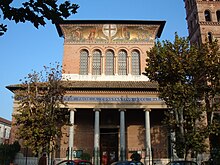Santa Croce in Via Flaminia
| Santa Croce in Flaminia Holy Cross on via Flaminia (English) Sancti Crucis in via Flaminia (Latin) |
|
|---|---|

Santa Croce in Via Flaminia
|
|
| Basic information | |
| Location |
|
| Affiliation | Roman Catholic |
| District | Lazio |
| Province | Rome |
| Country | Italy |
| Year consecrated | 1918 |
| Ecclesiastical or organizational status | Titular church |
| Leadership | Sergio da Rocha |
| Architectural description | |
| Architect(s) | Aristide Leonori |
| Architectural type | Church |
| Groundbreaking | 1913 |
| Completed | 1914 |
Santa Croce in Via Flaminia is a basilica church dedicated to the Holy Cross on the Via Flaminia in Rome, Italy.
It was first built in 1913 by the architect Aristide Leonori for Pope Pius X, in celebration of the 1600th anniversary of the Edict of Milan. In the style of a Roman basilica, it has a mosaic-decorated facade, a portico with six Doric columns and a mosaic by Biagio Biagetti, a five-storey bell tower and a three-aisled nave divided by six columns of Bavarian granite on each side.
It was opened for worship on 12 July 1914, and granted to the Congregation of the Sacred Stigmata (Stigmatines), but was not consecrated until 1918 (by Giuseppe Pallica, Titular Archbishop of Philippi).
In 1954, Pope Pius XII made it an alternative station church for Friday of the Fifth Week of Lent. Pope Paul VI elevated it to the status of Minor Basilica in 1964.
The Church of S. Croce was made a titular church for a Cardinal Priest by Pope Paul VI on 5 February 1965, an anticipation of a need for extra titles for new cardinals. On 22 February 1965 he created twenty-seven new Cardinals.
The position of titular priest of the church is Sergio da Rocha since 19 November 2016.
...
Wikipedia
